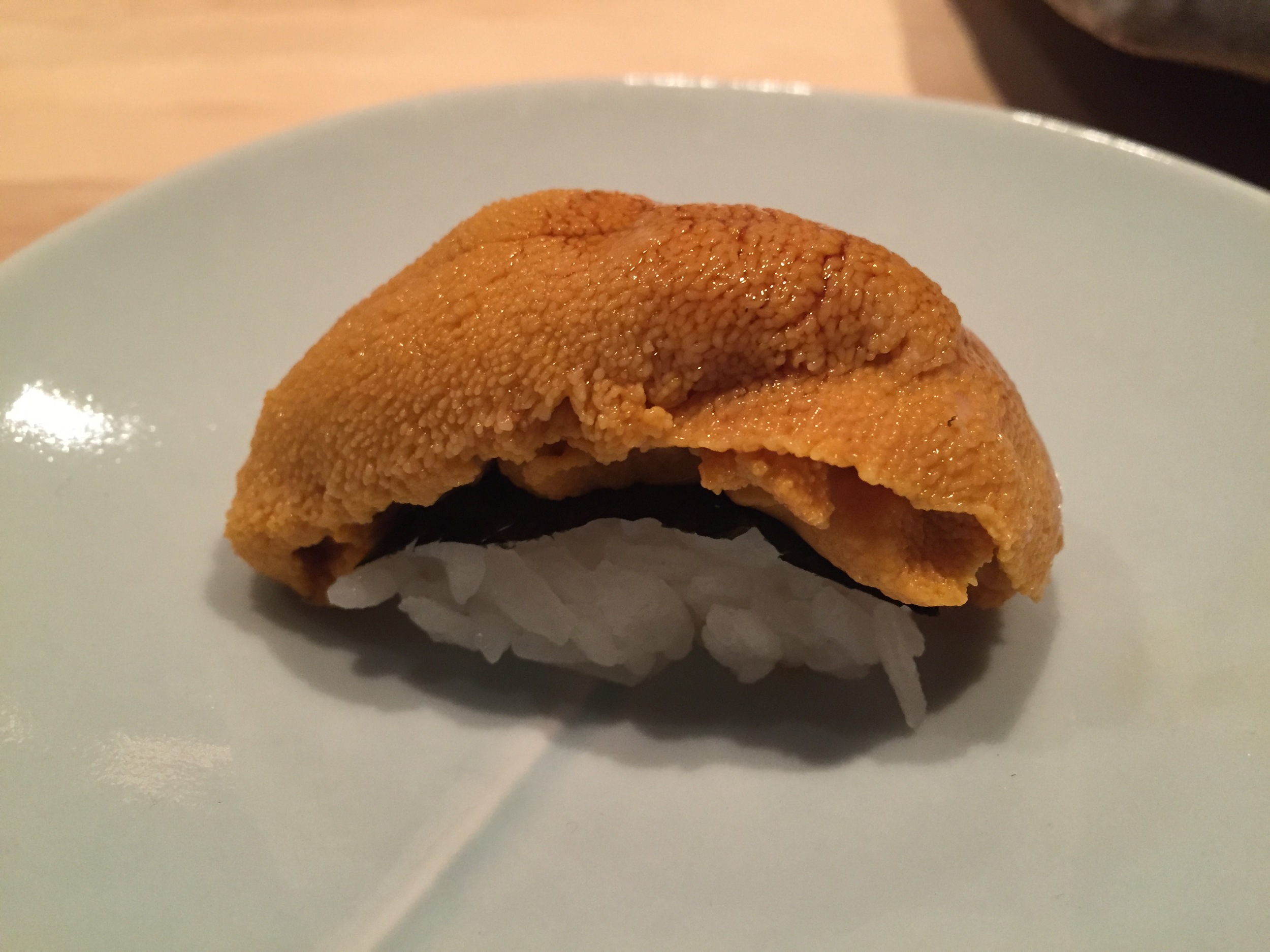- Cost: $150, before drinks, tax, and tip
- Size: 10 seats at counter
- Style: otsumami + sushi omakase
- Reserved: 2 weeks in advance
Kazunori Nozawa's sushiya, which closed in 2012, was a legendary fixture in Los Angeles. Sushi Nozawa has begat an empire of restaurants: three Sasabune locations run by apprentices (LA, NYC and Honolulu), the casual-targeted Sugarfish chain (8 restaurants and counting), and a shop focused on temaki as fast food. No sushiya typified the LA stereotype of a strip mall location and unassuming décor better. When critics first wrote about the famous signs proclaiming "NO spicy tuna" and "Today's Special: Trust Me" in the late 1980s, the idea of a expensive meal where the chef chose what you ate (especially for a Japanese restaurant) was all but unheard of in the US.
One of the most important distinctions between authentic sushi in Los Angeles and New York is the fact that, for a long time, quality LA sushiyas vastly outnumbered those in NYC. This balance began to shift sometime in the early-to-mid 2000s, which saw the opening in New York of places like Sushi Yasuda, the original Ichimura and Jewel Bako - all shops focused on providing a very authentic edomae sushi experience. The result of this trend is that the style of omakase at many NYC sushiya - with a more limited history - hews fairly close to what might be found in Japan. In contrast, in LA the syle has evolved, as sushiya have been serving their own form of omakase for more than 20 years. This timeline even predates the well-followed procession of neta (from light to heavy) developed by Jiro Ono in the 1990s, which has become the major influence on how sushi omakase is served.
I mention this because the Nozawa/Sasabune style - while referencing edomae sushi in many respects - really deserves its own distinction. I will admit that it is not my favorite style of sushi. Its calling cards include heavily-seasoned shari that is served warm (and sometimes even hot), the liberal use of ponzu as a condiment, and nigiri with a wide, almost "fat" shape. Most of the time, the neta is pre-sliced. Hikari mono are scarce. All meals end with a blue crab hand roll, a fixture at many west coast sushiya thanks to Nozawa. My guess is that the strong flavors of the shari and neta seasonings (as well as the lack of more esoteric fish) evolved over time with the American preference for bolder over more subtle flavors.
With all of this in mind, it was with great curiosity that I booked a meal at Nozawa Bar, which is the successor to the original and helmed by Osamu Fujita, one of Nozawa-san's protégés. The setting - a 10-seat wooden bar with perfect feng shui - evokes Ginza more than Los Angeles. Every aspect of the meal is carefully calibrated - from the neta preparation (different are fish stored at different temperatures) to subtle seasoning choices (four types of ponzu made their appearance) and small touches, such as ensuring crisp nori with maki. The result is an omakase that is a heavily-refined version of the trademark Nozawa/Sasabune style.
I found some of these refinements to be quite enjoyable. The careful storage of uni in individual portions completely eliminated the dreaded issue of "melted" uni that results when you are at the end of a tray (a decision so obvious that I am shocked all high-end sushiya don't store uni in this fashion). A piece of raw lobster that had been shocked in ice water and marinated with a bit of yuzu made for an excellent nigiri. The kansai-style tamago enveloping a pearl of ume and rice was probably the best version I have had outside of Japan.
But there were other stylistic decisions that didn't work as well for me. A piece of bigeye chutoro that had been aged for 10 days was served too cold to enjoy, twice (I encored this nigiri because I wasn't sure if there was some error the first time I tasted it). I don't know if bigeye was chosen versus overfished bluefin for environmentally-conscious or cost-conscious reasons, but the inferiority of this neta versus the richer (in both flavor and texture) bluefin was noticeable. The aging, rather than bringing out a depth of flavor, resulted in an almost mealy texture. A piece of char-grilled fresh unagi - a rarity in the US - was nearly drowned in tsume. And the constant use of ponzu was often too strong a counterbalance for subtle neta, making it difficult to discern the quality.
The shari itself was good, and whilst well-seasoned, much more balanced in flavor and temperature than the typical Nozawa/Sasabune style. With the exception of the first 2 or 3 nigiri (where the shari was "wet" and almost undercooked) the texture was also on point. Importantly, I found the size and balance of neta/shari to be quite good - likely a reflection of Fujita-san's skills and experience.
The neta selection was varied enough, but tended towards the "safer" side for American palates - no strongly-flavored hikari mono or crunchy shellfish like awabi or mirugai were available . I was also surprised to find that only akami and chutoro were offered at a shop in this price range. These facts, however, really reflect my own tastes rather than the quality of the shop.
As my preferences with sushi tend more towards the traditional, I am not sure if Nozawa Bar will be an experience to which I return (except perhaps for the tamago). Regardless, I can say with confidence that the shop is serving sushi at a high-level of technique and care in a distinctive and noteworthy style.
























